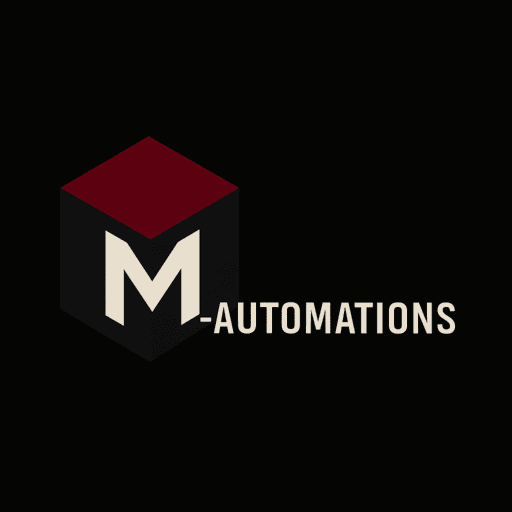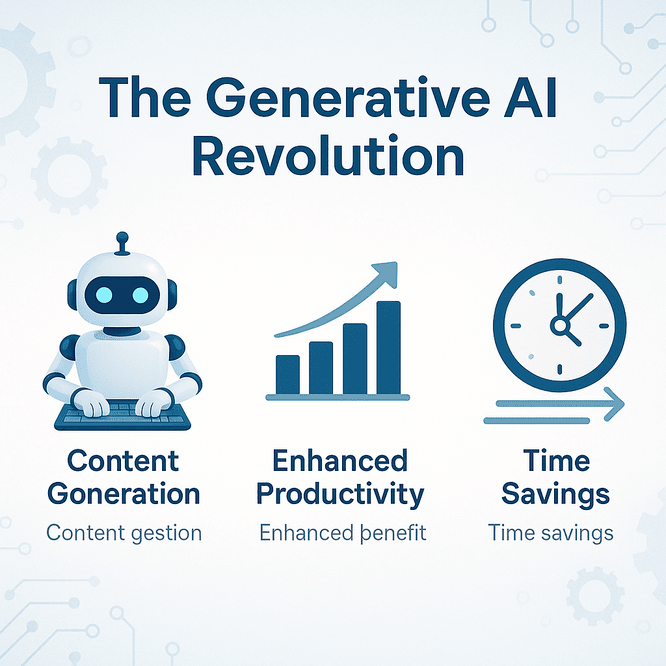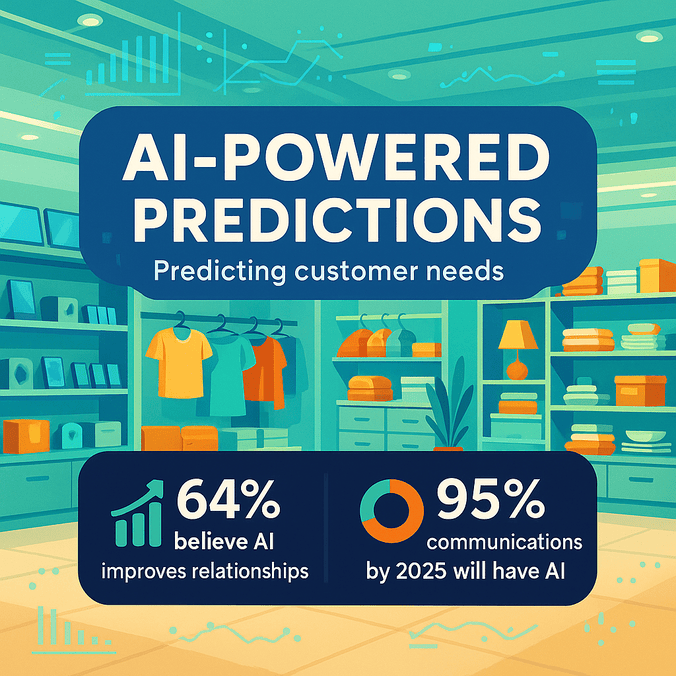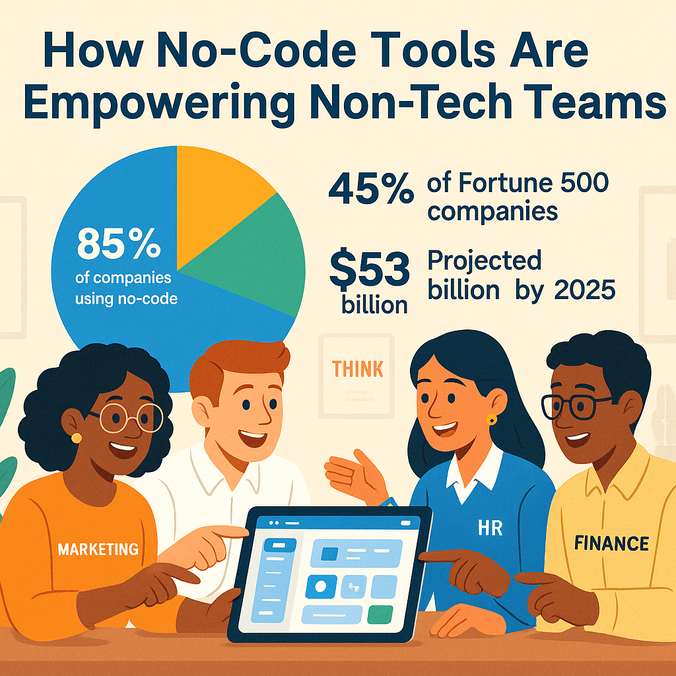Imagine a world where you could focus on your most important projects without being bogged down by tedious, repetitive tasks. Does that sound appealing? With the rise of generative AI, that world is not just a possibility—it's becoming a reality. This technology is making waves across industries by streamlining workflows and automating the drudgery that often consumes your work hours.
In this article, you'll learn about how generative AI is revolutionizing the way work is done and how you can leverage it to improve your efficiency and productivity. Whether you’re a business decision-maker, a busy professional, or someone simply looking to enhance your workday, understanding how generative AI can eliminate repetitive tasks is essential for your future success.
The Generative AI Revolution
Generative AI refers to algorithms capable of generating content, whether it be text, images, or even code, based on data inputs. This transformative technology is changing how we approach workflows by automating tasks that were once time-consuming and labor-intensive.
The Promise of Automation
Consider for a moment the many tasks that consume your day, from drafting emails to analyzing data. Generative AI can automate these processes at scale, relieving you of the burden of repetitive tasks. It’s not just about saving time; it's about redirecting your energy towards more strategic initiatives that can drive real value.
- Content Generation: Need to write a report or create marketing material? Generative AI can draft initial versions, saving hours of your time.
- Data Processing: Techniques like natural language processing allow AI to extract insights from vast datasets quickly, enabling quicker decision-making.
- Customer Service: Chatbots powered by generative AI can respond to common inquiries, ensuring customers receive timely support without overloading your team.
Enhanced Productivity
How much time do you spend on low-value tasks? Generative AI can significantly enhance your productivity by reducing the time spent on these activities. Research shows that businesses utilizing AI solutions report improvements in decision-making and operational speed. Early adopters are reaping outsized benefits; for every $1 invested in generative AI, organizations see an average return of $3.70.
The Numbers Speak
- ROI: For every dollar spent on generative AI, the return is an impressive $3.70.
- Adoption Rate: A staggering 73% of companies are either implementing or planning AI integrations.
- Employee Satisfaction: 89% of IT workers express greater job satisfaction due to automation.
The data clearly illustrates that generative AI is here to stay. Are you ready to seize these advantages for yourself?
The Financial Benefits of Generative AI
Let’s talk numbers. According to research by McKinsey, AI solutions like robotic process automation (RPA) can be dramatically more cost-efficient than human labor, costing one-third to one-fifth of human wages. This means that, not only can you streamline workflows, but you can also achieve significant savings.
Addressing Common Concerns
You might be worried about the initial investment required for AI tools. While there are upfront costs, consider the long-term savings and efficiency gains. When organizations begin to see their workflows transformed, that initial investment can quickly justify itself through reduced labor costs and improved efficiency.
Expert Opinions on the Shift Toward AI
Understanding different perspectives can provide deeper insights into the generative AI landscape. Notable analysts and industry leaders agree: The adoption of generative AI is rapidly transforming workplace dynamics.
“Agentic AI workforce models are seeing rapid enterprise adoption. By 2025, 55% of executives plan significant increases in AI spending.” – McKinsey Analysis
Thought leaders are pointing out that AI isn’t merely a technological shift; it’s a fundamental change in how work gets done. As Jason Cole, an industry commentator, puts it, “Generative AI lets designers and developers refine instead of create from scratch, accelerating innovation cycles.”
Current Trends Shaping the Future
The landscape of generative AI is continually evolving. Here are some key trends to watch:
- Agentic AI: These self-directed AI systems automate multi-step workflows, with 44% of IT leaders planning deployments in the coming years.
- Copilot Models: Tools like AI coding assistants promise productivity gains of up to 10 times for engineers.
- Unified Platforms: Businesses are leveraging AI solutions that integrate easily with existing tools, such as CRM systems, to minimize friction.
Staying abreast of these trends can help you make informed decisions about implementing generative AI solutions.
Actionable Strategies for Implementation
So, how can you start streamlining your workflows with generative AI? Here are some actionable insights:
- Identify High-Impact Tasks: Start with tasks that are highly repetitive, such as document processing or customer service inquiries.
- Prioritize Integration: Select AI tools that work seamlessly with your existing tech stack, like Salesforce or Microsoft 365, for a smoother transition.
- Measure Your ROI: Track metrics like time saved, error rates, and employee satisfaction. Understanding these metrics can guide your future AI strategies.
- Upskill Your Team: Invest in training for your staff on how to collaborate with AI tools effectively. This will maximize the synergy between human intelligence and artificial intelligence.
Pro Tip
Start small. Look for one or two tasks that consume a lot of your time and research AI solutions to automate those. Even small changes can lead to impressive time savings!
Common Mistakes to Avoid
Before diving into AI implementation, keep these common pitfalls in mind:
- Neglecting Integration: Implementing AI tools that don't fit with your current systems can lead to frustration and inefficiency.
- Underestimating Training Needs: Failing to educate your team on using AI tools effectively can result in suboptimal outcomes.
- Ignoring Metrics: Not tracking the impact of your AI solutions makes it difficult to justify your investments and improve in the future.
The Future of Work with Generative AI
As the world continuously adapts to AI technology, the question arises: what does the future of work look like? You can expect more self-directed systems that handle increasingly complex tasks with minimal input. The focus will shift from doing tasks to supervising and enhancing the work performed by generative AI.
What new possibilities await you as generative AI frees you from repetitive tasks? Picture a day where you can dedicate more time to innovative projects or personal development.
Calls to Action
Are you ready to dive into the world of generative AI and transform your work life? Start by identifying a few repetitive tasks today that you can automate.
- Explore AI Tools: Look into beginner-friendly services that can help streamline your workflows. Free trials are a great way to begin without any commitments.
- Consider Your Own Use Case: What three tasks could you automate right now? Make a list and start your journey into automation!
Key Takeaways
- Generative AI is revolutionizing the way work is done by automating repetitive tasks.
- Businesses report significant ROI and increased employee satisfaction due to automation.
- Focus on integrating AI solutions that fit your existing tech stack for smoother implementation.
- Start small by automating high-impact tasks, and measure the outcomes for continuous improvement.
As generative AI continues to evolve, are you prepared to take advantage of the opportunities it presents? The time to act is now!
Frequently Asked Questions
What is generative AI, and how can it help my business?
Generative AI refers to advanced technology that can create content, produce code, and automate tasks that were previously done by humans. Here’s how it can help your business:
- Automates repetitive tasks, freeing up time for strategic work.
- Enhances productivity by improving efficiency and reducing errors.
- Provides cost-effective solutions that are cheaper than traditional labor.
Can generative AI really reduce costs?
Absolutely! Many businesses have seen significant cost reductions after implementing generative AI. Here’s why:
- AI solutions can cost one-third to one-fifth of human labor.
- Automating mundane tasks means lower overhead costs in the long run.
- Increased efficiency often leads to faster project completion, saving time and money.
How can I measure the ROI of generative AI in my workflows?
Measuring ROI can seem tricky, but here are some straightforward metrics to consider:
- Time saved on automated tasks.
- Reduction in errors or issues compared to manual processes.
- Employee satisfaction scores before and after implementation.
What types of tasks are best suited for generative AI?
Generative AI shines in automating repetitive, rule-based tasks. Here are some examples:
- Document processing (like invoice data extraction).
- Customer service responses through chatbots.
- Data analysis and reporting.
We're a small business—can we afford generative AI?
Definitely! Generative AI is becoming more accessible for businesses of all sizes. Here’s why it’s worth considering:
- Lower initial investment compared to hiring additional staff.
- Scalable solutions that can grow with your business.
- Many tools offer free trials or pay-as-you-go plans.
How do I choose the right generative AI tools for my team?
Selecting the right generative AI tools can be made easier by following these steps:
- Evaluate your specific needs (what tasks you want to automate).
- Look for tools that integrate with your existing systems (like CRMs).
- Read reviews and opt for user-friendly solutions for smooth adoption.
What should I do if my team is resistant to using generative AI?
Resistance is natural, but you can help your team adapt by:
- Providing training sessions to ease them into AI tools.
- Demonstrating how AI can make their work easier, not threaten their jobs.
- Encouraging feedback and involving them in the implementation process.
Can generative AI assist in creative tasks, or is it just for data-heavy jobs?
Great question! Generative AI can definitely support creative tasks. Here’s how:
- Generates content ideas and drafts, saving time for refinement.
- Helps designers by providing inspiration or design prototypes.
- Even assists in coding, allowing developers to focus on complex solutions.
How should I prepare my team for working alongside generative AI?
Preparing your team involves focusing on collaboration and mindset:
- Encourage a culture of learning and openness to new technologies.
- Consider workshops or training on how to leverage AI tools effectively.
- Promote teamwork, highlighting that AI is a partner, not a replacement.



